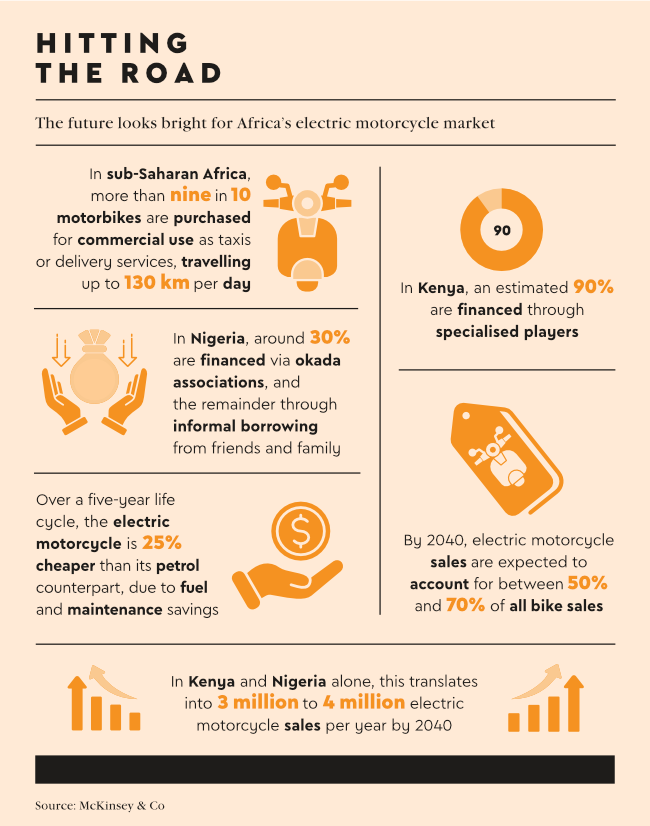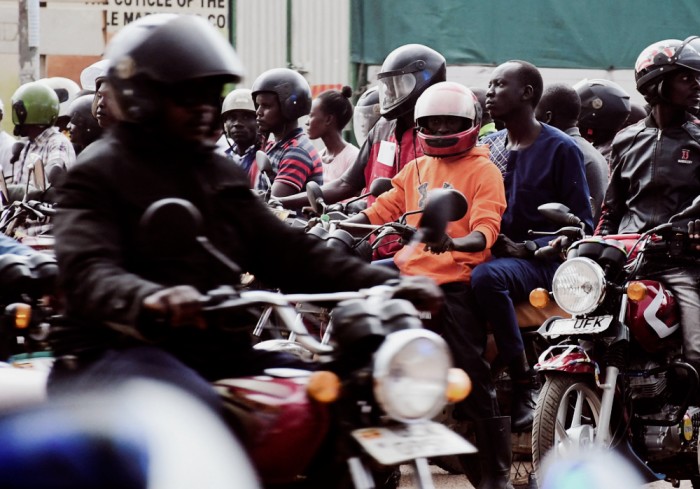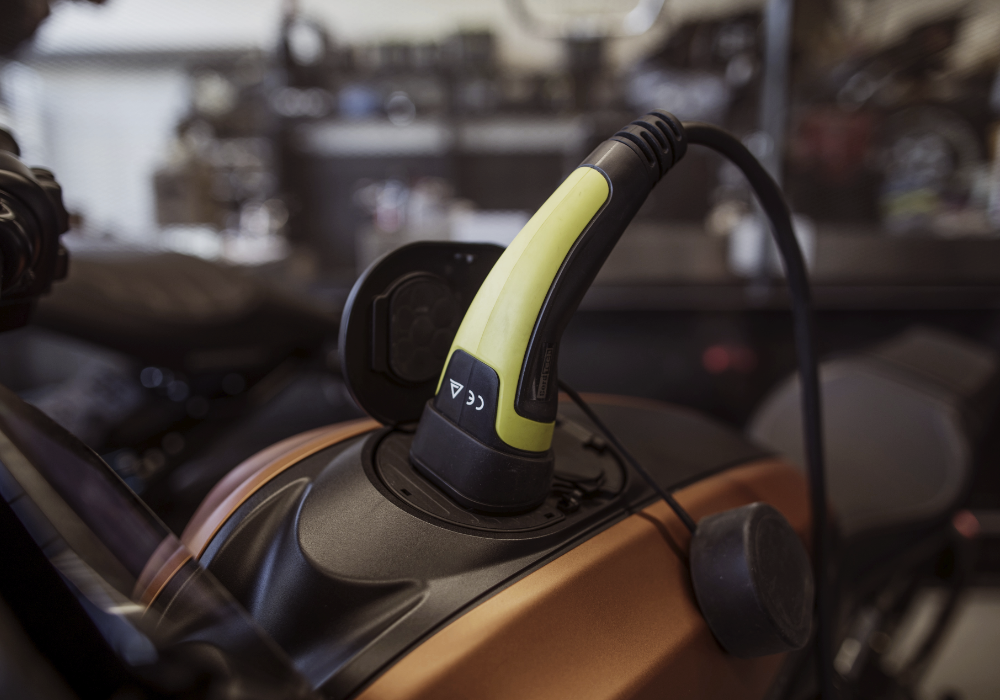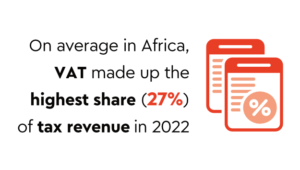In East Africa they are known as boda bodas. In Nigeria, they go by the name okadas. Taxi-moto is the term mostly used in French-speaking countries. They are the ubiquitous, informal motorcycle taxis that have become a feature of most public transport systems on the continent.
The BBC reports that there are about 3 million boda boda riders in Kenya alone, with the UN estimating that about 5 million people benefit from the income generated by the riders. But most of the motorbikes are powered by petrol engines, which contribute to carbon emissions, noise and pollution.
In the quest for sustainable transportation solutions, the transition to electric vehicles (EVs) has emerged as a promising pathway to enhance energy efficiency. However, one of the primary barriers to widespread adoption of electric vehicles in developing countries is the high upfront cost associated with electric cars.
Electric motorcycles, on the other hand, offer a more economically accessible option for consumers in these regions.
According to Charging Ahead – Accelerating E-mobility in Africa, a report released last year by the Powering Renewable Energy Opportunities (PREO) programme, ‘electric motorcycles have significantly lower operating and maintenance costs than ICE [internal combustion engine] alternatives, which allows drivers to generate higher profit margins from the same revenue base, leading to higher earning potential and improved livelihoods’.
With lower purchase prices and operating costs compared to electric cars, electric motorcycles present a viable transportation solution for individuals and businesses in developing countries, particularly in rural areas where public transportation infrastructure is limited.

Furthermore, electric motorcycles provide income-generating opportunities for entrepreneurs and small businesses, such as delivery services and ride-sharing platforms. The lower entry barrier enables a broader segment of the population to participate in the electric mobility ecosystem, fostering economic empowerment and inclusive growth.
The infrastructure requirements for electric motorcycles are significantly less demanding compared to electric cars, making them better suited for the infrastructural realities of developing countries. Charging infrastructure for electric motorcycles can be more easily deployed in urban and rural areas, leveraging existing electrical grids and decentralised charging solutions.
One such company making use of this formula is Spiro (originally known as M-AUTO), which was established in 2022 in West Africa. From Benin and Togo it has expanded to other countries such as Rwanda and Uganda –and now Kenya – where, in September last year, it announced it had partnered with the government to provide 1.2 million electric vehicles to the country.
‘We have established a network of battery-swapping stations strategically located in key cities. These stations allow our customers to easily exchange their depleted electric motorcycle batteries for fully charged ones, eliminating the need for long charging times,’ Spiro CEO Jules Samain told How We Made It in Africa. ‘This approach ensures that our riders experience minimal downtime and can maximise the use of their electric motorcycles. Our electric motorcycle exchange programme has been instrumental in accelerating the adoption of sustainable transportation. We offer drivers of [traditional] motorcycles the opportunity to exchange their vehicles for electric motorcycles.
‘Through this programme, we make electric mobility accessible and financially viable for these drivers, creating a win-win situation for both the drivers and the environment.’ Spiro has committed to building 3 000 battery-swapping stations across Kenya as well as a bike manufacturing plant.
Also in September last year, AFP reported that Uber would introduce electric motorcycle taxis in the Kenyan capital Nairobi. The Electric Boda fleet will consist of an initial 3 000 bikes. It said it ‘would cut running costs for drivers by 30% to 35% and reduce fares by about 15% to 20%’.

From an energy-efficiency standpoint, electric motorcycles offer several advantages over electric cars. Electric motorcycles typically have higher energy-efficiency ratings and lower energy consumption per kilometre travelled compared to electric cars, owing to their lighter weight and streamlined design.
CNN reports that a study by the FIA Foundation found that ‘while the purchase price of electric motorcycles is currently greater than that of petrol-powered motorcycles, the operating costs are cheaper. In many African countries, it says, one litre of petrol will power a bike for about the same distance as one kilowatt-hour of electricity, but will cost five to 10 times more’.
Furthermore, electric motorcycles offer opportunities for local manufacturing and job creation, as evidenced by the emergence of electric motorcycle start-ups and manufacturing hubs in countries such as Rwanda, where Ampersand launched in 2019.
Ampersand’s fleet has grown to around 1 000 in size, and DisruptAfrica reports that the company wants to exceed 10 000 bikes by late 2024.
‘We are ramping up local production of our battery packs to meet growing client demand for our e-motos and continuing to innovate for a more sustainable public transport option for East Africans,’ Alp Tilev, co-founder and CTO of Ampersand, told the website.
It has a network so far of 25 battery-swap stations across Kenya and Rwanda where riders can exchange empty batteries for newly charged ones within two minutes.
Roam, another manufacturer of e-motorbikes, hosted Kenyan President William Ruto in July 2023 when it inaugurated its 10 000 m2 manufacturing plant in Nairobi. The facility ‘is the largest electric motorcycle assembly plant in East Africa, with an annual production capacity of 50 000 units that will be reached in a few years’, according to the company.

Its CEO, Filip Lövström, told CNN that it chose to design its model ‘from scratch because no existing motorcycles matched local users’ needs. We need something that is very strong, very versatile, very robust, easy to repair and cheap at the same time’. The company’s Roam Air motorcycle can carry a load of 220 kg, reach a top speed of 90 km per hour and has a 150 km range on its dual battery.
In March this year, the company announced that it had secured equity and debt funding of US$24 million. ‘Funds from this round will be invested in expanding local manufacturing capabilities in Kenya, scaling up production at the new Roam Park facility, investing in research and tooling for cost efficiencies, and streamlining local and global supply chain networks. These efforts align with Roam’s long-term goal of transitioning the transport sector across Africa to effective and affordable electric vehicles, leveraging locally sourced parts and existing large-scale manufacturing infrastructure,’ according to the company.
Electric motorcycles are not only more gentle on the planet – they offer a quieter alternative to conventional petrol-powered motorcycles too, thereby reducing noise as well as air pollution in densely populated areas. By transitioning to electric motorcycles, developing countries can mitigate the adverse environmental and public health impacts associated with traditional internal combustion engine vehicles, fostering more sustainable urban development.
As the PREO report put it, ‘our ongoing research indicates that increasing climate and private-sector financing flows will rapidly accelerate the adoption of electric motorcycles and, in doing so, unlock transformative socio-economic and environmental solutions. The transition to electric motorcycles will provide tangible evidence that the climate transition can be a win-win scenario’.
















